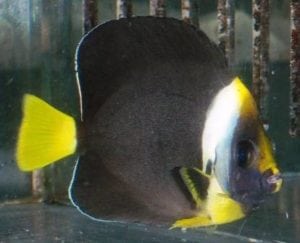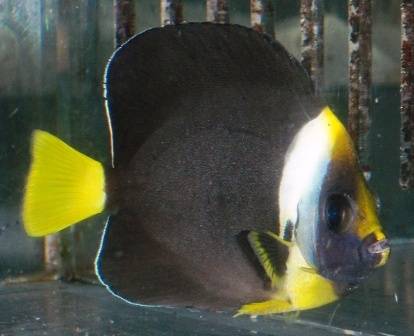Care Requirements for the Personifer Angelfish (Chaetodontoplus personifer)
- Care Level: Moderate
- Temperament: Semi-aggressive
- Diet: Omnivore
- Reef Compatible: With Caution
- Max. Size: 1′ 2″
- Origin: Australia
- Family: Pomacanthidae
- Minimum Tank Size: 180 gallons
- Common names: Blueface Angelfish, Western Yellowtail, Yellowface Angelfish
- Water Conditions: 72-78° F, dKH 8-12, pH 8.1-8.4, sg 1.020-1.025

Physical Characteristics of the Personifer Angelfish
The personifer angelfish typically grows to 9-14 inches at full adulthood. Its thin, oval-like bodies are nearly all black with a light colored head. Their heads can be brightly colored, ranging the palette from blues to greens and yellow. The males, in particular, have a unique yellow-speckled pattern all along the head. The other way they are morphologically different than females is males have slightly longer bodies. This is one of the few species of angelfish that have these noticeable differences between the genders.
Like all angelfish, the personifer has a rather sharp spine with filaments sticking out from each individual fin. Use caution when transporting as this can easily tear through any plastic bag. Perhaps the most unique physical attribute is the caudal fin that is brightly colored, providing a beautiful contrast for the dull and muted coloration of the body.
A dead give away to identifying a true personifer angelfish, is they will have a thick black band running through the caudal fin. Sister-species, known as classic personifers (C. meridithi) found in the eastern coastal waters of Australia do not have this.
Tank Conditions for Personifer Angelfish
Largely considered to be a hardy fish, Personifers adapt well under the right conditions. Firstly, plenty of swimming room is necessary. This should be unobstructed and not over-populated with other types of fish. This will keep your angelfish’s temperament happy and reduce its aggressiveness. You should generally not have more than one per tank unless you have a large aquarium that meets the following standards:
- 100 gal (400 liters): Several small Angelfish (<15cm) can live together.
- 240 gal (900 liters): Several medium Angelfish (< 20cm) can live together.
- 400 gal (1500 liters): Several large Angelfish (<25cm) can live together.
There should also be sufficient areas to hide when tired or feeling stressed. Factors like this will add to the fish’s overall quality of life in the tank, giving you more years to enjoy its beauty.
Proper filtration is a must as well, one that is highly oxygenated and is cleaned regularly. Look to replace approximately 20% of the water on a weekly basis with a 100-gallon tank. This vastly reduces the occurrence of disease and parasites in the water.
Feeding Your Personifer Angelfish
Their diet is mostly plant-based. This is best for keeping the fish at its healthiest. Plants can be supplemented with meaty proteins at times by feeding frozen shrimp. This particular species also likes to eat tubeworms. They should be fed 2-3 times a day, and it is a great idea to keep liverock in the tank for additional grazing.
Dried algae flakes, seaweed like nori, spirulina, and other nutritional supplements are all good options.
Find more information on Angelfish by viewing our other articles


















